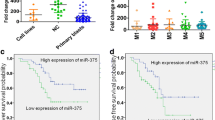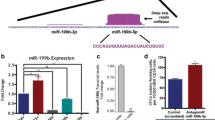Abstract
MicroRNAs (miRNAs, miRs) are postulated to be important regulators in various cancers, including leukemia. In a large-scale miRNA expression profiling analysis of 435 human miRNAs in 52 acute myeloid leukemia (AML) samples, we found that miR-126 and its minor counterpart in biogenesis, namely, miR-126*, were specifically aberrantly overexpressed in core binding factor (CBF) AMLs including both t(8;21)/AML1-ETO and inv(16)/CBFB-MYH11 samples. Our in vitro gain- and loss-of-function experiments showed that forced expression of miR-126 inhibited apoptosis and increased the viability of AML cells, whereas the opposite effect was observed when endogenous expression of miR-126 was knocked down. In addition, through in vitro colony-forming/replating assays, we demonstrated that forced expression of miR-126 enhanced proliferation and colony-forming/replating capacity of mouse normal bone marrow progenitor cells alone and particularly, in cooperation with AML1-ETO, a fusion gene resulting from t(8;21). Thus, our data shows that miR-126 may play a critical role in the development of CBF leukemias. In the present chapter, the materials and protocols for the study of miR-126 in leukemia are described.
Access this chapter
Tax calculation will be finalised at checkout
Purchases are for personal use only
Similar content being viewed by others
References
Bartel, D. P. (2004) MicroRNAs: genomics, biogenesis, mechanism, and function. Cell 116, 281–297.
Wu, W., Sun, M., Zou, G. M., and Chen, J. (2007) MicroRNA and cancer: current status and prospective. Int J Cancer 120, 953–960.
Croce, C. M., and Calin, G. A. (2005) miRNAs, cancer, and stem cell division. Cell 122, 6–7.
Esquela-Kerscher, A., and Slack, F. J. (2006) Oncomirs – microRNAs with a role in cancer. Nat Rev Cancer 6, 259–269.
He, L., Thomson, J. M., Hemann, M. T., Hernando-Monge, E., Mu, D., Goodson, S., Powers, S., Cordon-Cardo, C., Lowe, S. W., Hannon, G. J., and Hammond, S. M. (2005) A microRNA polycistron as a potential human oncogene. Nature 435, 828–833.
Tagawa, H., Karube, K., Tsuzuki, S., Ohshima, K., and Seto, M. (2007) Synergistic action of the microRNA-17 polycistron and Myc in aggressive cancer development. Cancer Sci 98, 1482–1490.
Voorhoeve, P. M., le Sage, C., Schrier, M., Gillis, A. J., Stoop, H., Nagel, R., Liu, Y. P., van Duijse, J., Drost, J., Griekspoor, A., Zlotorynski, E., Yabuta, N., De Vita, G., Nojima, H., Looijenga, L. H., and Agami, R. (2006) A genetic screen implicates miRNA-372 and miRNA-373 as oncogenes in testicular germ cell tumors. Cell 124, 1169–1181.
Chan, J. A., Krichevsky, A. M., and Kosik, K. S. (2005) MicroRNA-21 is an antiapoptotic factor in human glioblastoma cells. Cancer Res 65, 6029–6033.
Kluiver, J., Poppema, S., de Jong, D., Blokzijl, T., Harms, G., Jacobs, S., Kroesen, B. J., and van den Berg, A. (2005) BIC and miR-155 are highly expressed in Hodgkin, primary mediastinal and diffuse large B cell lymphomas. J Pathol 207, 243–249.
Costinean, S., Zanesi, N., Pekarsky, Y., Tili, E., Volinia, S., Heerema, N., and Croce, C. M. (2006) Pre-B cell proliferation and lymphoblastic leukemia/high-grade lymphoma in E(mu)-miR155 transgenic mice. Proc Natl Acad Sci U S A 103, 7024–7029.
Ma, L., Teruya-Feldstein, J., and Weinberg, R. A. (2007) Tumour invasion and metastasis initiated by microRNA-10b in breast cancer. Nature 449, 682–688.
Calin, G. A., Dumitru, C. D., Shimizu, M., Bichi, R., Zupo, S., Noch, E., Aldler, H., Rattan, S., Keating, M., Rai, K., Rassenti, L., Kipps, T., Negrini, M., Bullrich, F., and Croce, C. M. (2002) Frequent deletions and down-regulation of micro- RNA genes miR15 and miR16 at 13q14 in chronic lymphocytic leukemia. Proc Natl Acad Sci U S A 99, 15524–15529.
Cimmino, A., Calin, G. A., Fabbri, M., Iorio, M. V., Ferracin, M., Shimizu, M., Wojcik, S. E., Aqeilan, R. I., Zupo, S., Dono, M., Rassenti, L., Alder, H., Volinia, S., Liu, C. G., Kipps, T. J., Negrini, M., and Croce, C. M. (2005) miR-15 and miR-16 induce apoptosis by targeting BCL2. Proc Natl Acad Sci USA 102, 13944–13949.
Johnson, S. M., Grosshans, H., Shingara, J., Byrom, M., Jarvis, R., Cheng, A., Labourier, E., Reinert, K. L., Brown, D., and Slack, F. J. (2005) RAS is regulated by the let-7 microRNA family. Cell 120, 635–647.
He, L., He, X., Lim, L. P., de Stanchina, E., Xuan, Z., Liang, Y., Xue, W., Zender, L., Magnus, J., Ridzon, D., Jackson, A. L., Linsley, P. S., Chen, C., Lowe, S. W., Cleary, M. A., and Hannon, G. J. (2007) A microRNA component of the p53 tumour suppressor network. Nature 447, 1130–1134.
Lu, J., Getz, G., Miska, E. A., Alvarez-Saavedra, E., Lamb, J., Peck, D., Sweet-Cordero, A., Ebert, B. L., Mak, R. H., Ferrando, A. A., Downing, J. R., Jacks, T., Horvitz, H. R., and Golub, T. R. (2005) MicroRNA expression profiles classify human cancers. Nature 435, 834–838.
Bloomfield, C. D., Ruppert, A. S., Mrozek, K., Kolitz, J. E., Moore, J. O., Mayer, R. J., Edwards, C. G., Sterling, L. J., Vardiman, J. W., Carroll, A. J., Pettenati, M. J., Stamberg, J., Byrd, J. C., Marcucci, G., and Larson, R. A. (2004) Core binding factor acute myeloid leukemia. Cancer and Leukemia Group B (CALGB) Study 8461. Ann Hematol 83 Suppl 1, S84–S85.
de Bruijn, M. F., and Speck, N. A. (2004) Core-binding factors in hematopoiesis and immune function. Oncogene 23, 4238–4248.
Look, A. T. (1997) Oncogenic transcription factors in the human acute leukemias. Science 278, 1059–1064.
Strout, M. P., Marcucci, G., Caligiuri, M. A., and Bloomfield, C. D. (1999) Core-binding factor (CBF) and MLL-associated primary acute myeloid leukemia: biology and clinical implications. Ann Hematol 78, 251–264.
Gilliland, D. G. (2001) Hematologic malignancies. Curr Opin Hematol 8, 189–191.
Pui, C. H., and Jeha, S. (2007) New therapeutic strategies for the treatment of acute lymphoblastic leukaemia. Nat Rev Drug Discov 6, 149–165.
Castilla, L. H., Garrett, L., Adya, N., Orlic, D., Dutra, A., Anderson, S., Owens, J., Eckhaus, M., Bodine, D., and Liu, P. P. (1999) The fusion gene Cbfb-MYH11 blocks myeloid differentiation and predisposes mice to acute myelomonocytic leukaemia. Nat Genet 23, 144–146.
Yuan, Y., Zhou, L., Miyamoto, T., Iwasaki, H., Harakawa, N., Hetherington, C. J., Burel, S. A., Lagasse, E., Weissman, I. L., Akashi, K., and Zhang, D. E. (2001) AML1-ETO expression is directly involved in the development of acute myeloid leukemia in the presence of additional mutations. Proc Natl Acad Sci USA 98, 10398–10403.
Higuchi, M., O’Brien, D., Kumaravelu, P., Lenny, N., Yeoh, E. J., and Downing, J. R. (2002) Expression of a conditional AML1-ETO oncogene bypasses embryonic lethality and establishes a murine model of human t(8;21) acute myeloid leukemia. Cancer Cell 1, 63–74.
de Guzman, C. G., Warren, A. J., Zhang, Z., Gartland, L., Erickson, P., Drabkin, H., Hiebert, S. W., and Klug, C. A. (2002) Hematopoietic stem cell expansion and distinct myeloid developmental abnormalities in a murine model of the AML1-ETO translocation. Mol Cell Biol 22, 5506–5517.
Peterson, L. F., Boyapati, A., Ahn, E. Y., Biggs, J. R., Okumura, A. J., Lo, M. C., Yan, M., and Zhang, D. E. (2007) Acute myeloid leukemia with the 8q22;21q22 translocation: secondary mutational events and alternative t(8;21) transcripts. Blood 110, 799–805.
Eisen, M. B., Spellman, P. T., Brown, P. O., and Botstein, D. (1998) Cluster analysis and display of genome-wide expression patterns. Proc Natl Acad Sci USA 95, 14863–14868.
Saeed, A. I., Bhagabati, N. K., Braisted, J. C., Liang, W., Sharov, V., Howe, E. A., Li, J., Thiagarajan, M., White, J. A., and Quackenbush, J. (2006) TM4 microarray software suite. Methods Enzymol 411, 134–193.
Lavau, C., Du, C., Thirman, M., and Zeleznik-Le, N. (2000) Chromatin-related properties of CBP fused to MLL generate a myelodysplastic-like syndrome that evolves into myeloid leukemia. Embo J 19, 4655–4664.
Lavau, C., Luo, R. T., Du, C., and Thirman, M. J. (2000) Retrovirus-mediated gene transfer of MLL-ELL transforms primary myeloid progenitors and causes acute myeloid leukemias in mice. Proc Natl Acad Sci USA 97, 10984–10989.
Lavau, C., Szilvassy, S. J., Slany, R., and Cleary, M. L. (1997) Immortalization and leukemic transformation of a myelomonocytic precursor by retrovirally transduced HRX-ENL. Embo J 16, 4226–4237.
Slany, R. K., Lavau, C., and Cleary, M. L. (1998) The oncogenic capacity of HRX-ENL requires the transcriptional transactivation activity of ENL and the DNA binding motifs of HRX. Mol Cell Biol 18, 122–129.
Luo, R. T., Lavau, C., Du, C., Simone, F., Polak, P. E., Kawamata, S., and Thirman, M. J. (2001) The elongation domain of ELL is dispensable but its ELL-associated factor 1 interaction domain is essential for MLL-ELL-induced leukemogenesis. Mol Cell Biol 21, 5678–5687.
Li, Z., Lu, J., Sun, M., Mi, S., Zhang, H., Luo, R. T., Chen, P., Wang, Y., Yan, M., Qian, Z., Neilly, M. B., Jin, J., Zhang, Y., Bohlander, S. K., Zhang, D. E., Larson, R. A., Le Beau, M. M., Thirman, M. J., Golub, T. R., Rowley, J. D., and Chen, J. (2008) Distinct microRNA expression profiles in acute myeloid leukemia with common translocations. Proc Natl Acad Sci U S A 105, 15535–15540.
Okuda, T., Cai, Z., Yang, S., Lenny, N., Lyu, C. J., van Deursen, J. M., Harada, H., and Downing, J. R. (1998) Expression of a knocked-in AML1-ETO leukemia gene inhibits the establishment of normal definitive hematopoiesis and directly generates dysplastic hematopoietic progenitors. Blood 91, 3134–3143.
Acknowledgements
We thank Dr. P. Paul Liu at National Human Genome Research Institute for providing the ME-1 cell line and Dr. Dong-Er Zhang for providing the MIGR1-AE construct. This work was supported in part by National Institutes of Health (NIH) CA127277 (J.C.) and the G. Harold and Leila Y. Mathers Charitable Foundation (J.C.).
Author information
Authors and Affiliations
Editor information
Editors and Affiliations
Rights and permissions
Copyright information
© 2011 Springer Science+Business Media, LLC
About this protocol
Cite this protocol
Li, Z., Chen, J. (2011). In Vitro Functional Study of miR-126 in Leukemia. In: Wu, W. (eds) MicroRNA and Cancer. Methods in Molecular Biology, vol 676. Humana Press, Totowa, NJ. https://doi.org/10.1007/978-1-60761-863-8_13
Download citation
DOI: https://doi.org/10.1007/978-1-60761-863-8_13
Published:
Publisher Name: Humana Press, Totowa, NJ
Print ISBN: 978-1-60761-862-1
Online ISBN: 978-1-60761-863-8
eBook Packages: Springer Protocols




